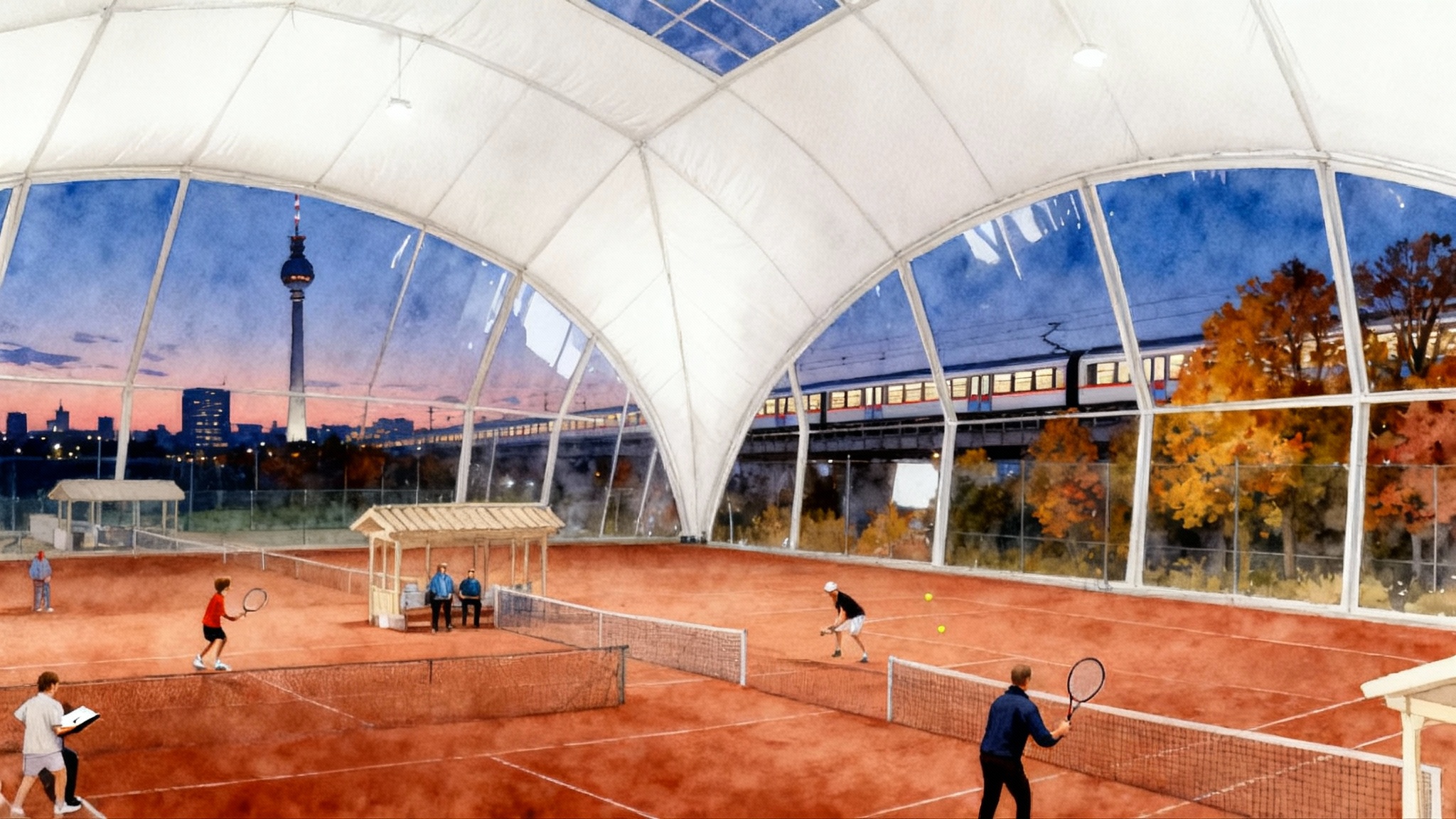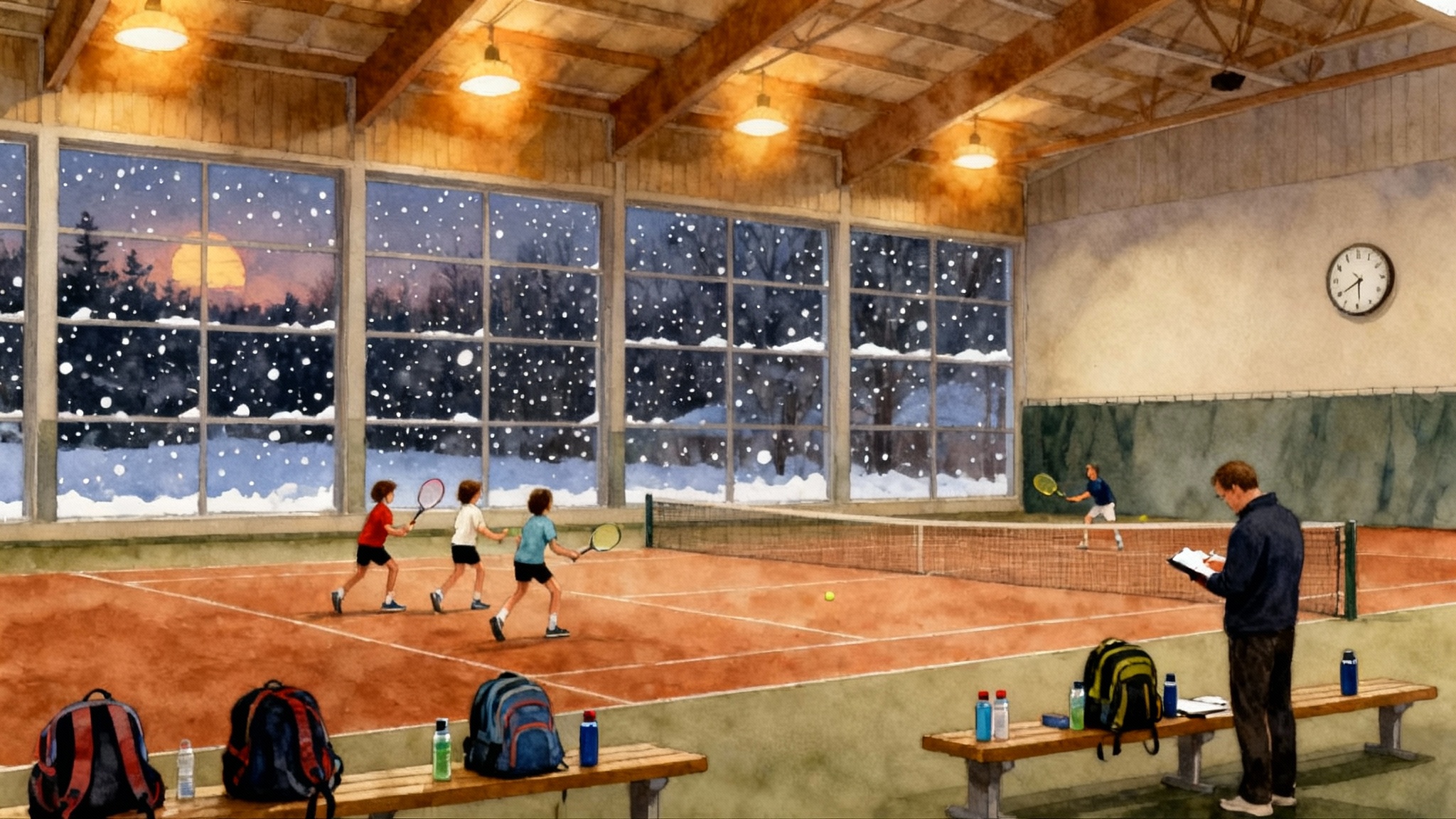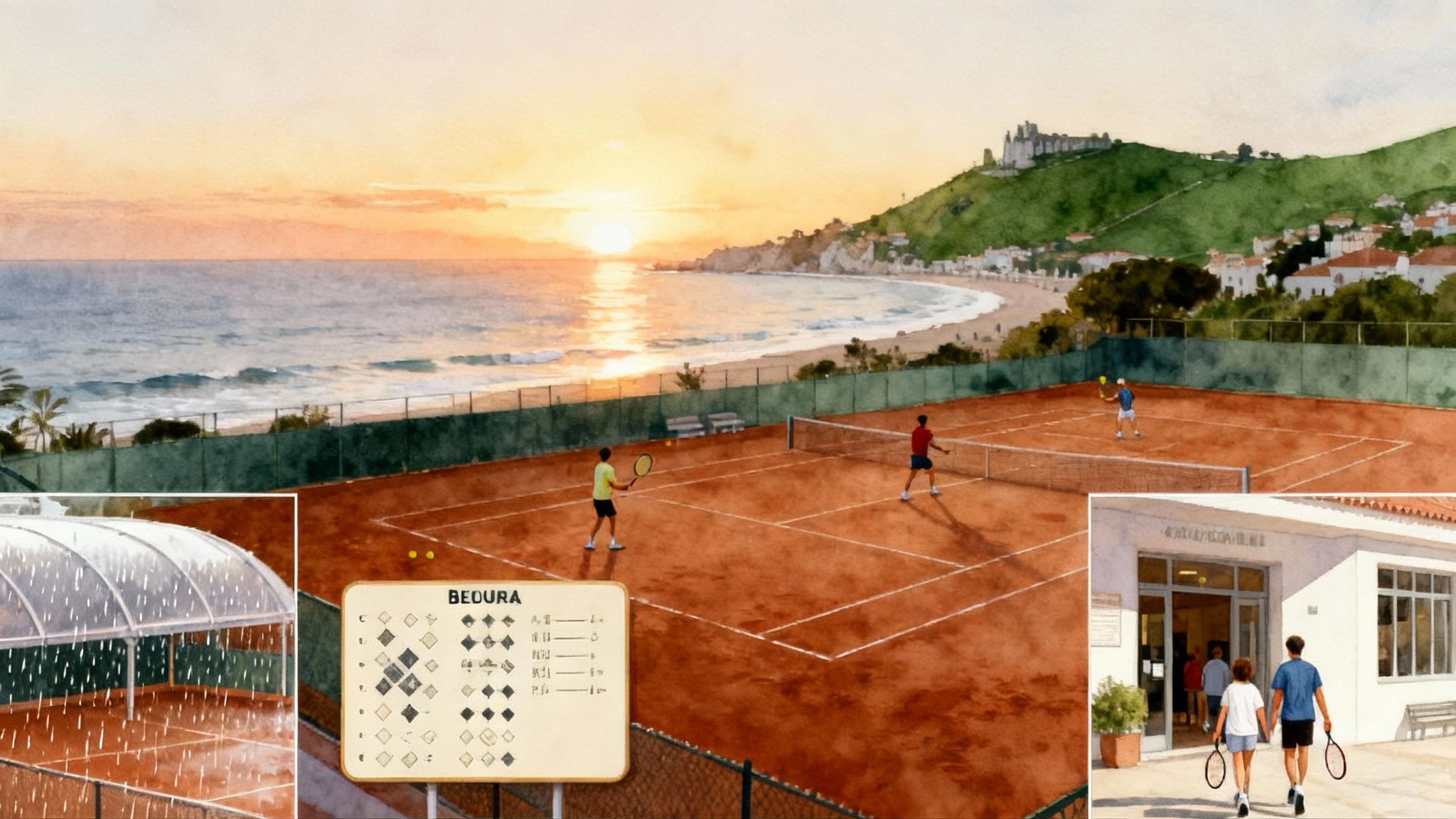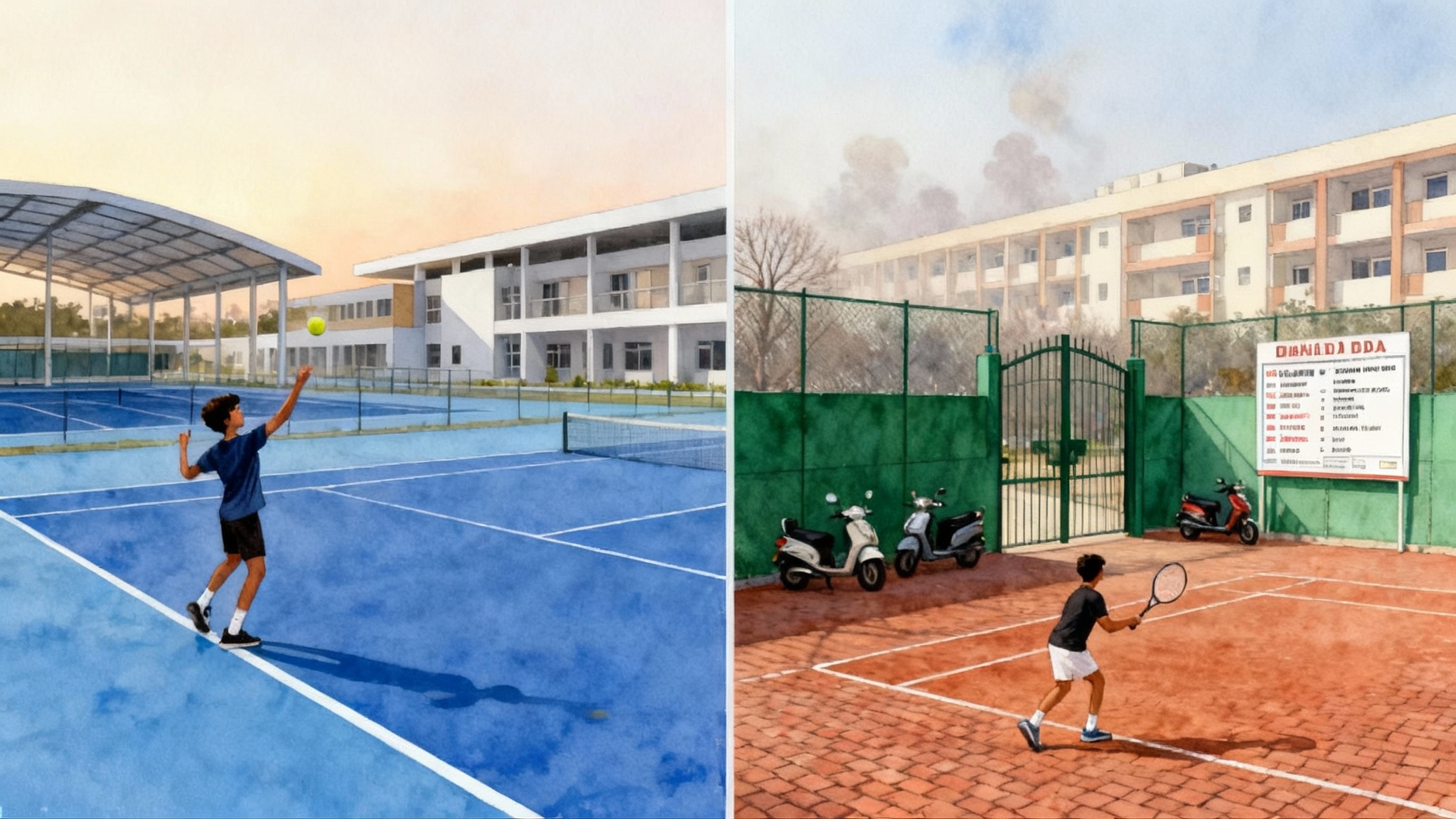Best Berlin Tennis Academies 2025–2026 for Juniors and Adults
A practical, enrollment-season guide to Berlin’s top tennis academies. Compare club‑integrated programs and independents like TennisTree Berlin, with notes on winter domes, clay vs hard courts, English‑friendly coaching, prices, commute, trials, and league pathways.

How to use this guide
Enrollment season in Berlin runs on two clocks. Outdoor summer runs roughly April to September. Winter training begins in early October and lives under air domes and in permanent halls. This guide compares the city’s strongest options for 2025–2026, with a practical focus on how you will train week to week. We cover surfaces, winter access, English-friendly coaching, transparent price bands, commute reality, how to book a trial lesson, and concrete pathways into German league play, Universal Tennis Rating match play, and International Tennis Federation juniors.
Who this is for
Families planning a full year of junior tennis, adult improvers returning to the game, and performance players who want a clear route into competitive play without guesswork.
Berlin’s year-round tennis, in one picture
- Summer is mostly red clay outdoors. The ball bounces higher and slower than on hard courts, which is kinder on joints and rewards patience and topspin.
- Winter moves indoors. Many clubs inflate air domes over clay courts, and several have permanent carpet or cushioned acrylic halls. Expect slightly faster ball speed indoors and lower bounce, so footwork and compact swings matter.
- The practical implication: if you want a hard-court feel all year, look for clubs that list cushioned acrylic or carpet indoors and hard or cushioned acrylic outdoors. If you are building a foundational game for Europe, regular clay time remains invaluable.
Club-integrated academies vs independent schools
Both models work in Berlin. The better fit depends on your goals, schedule, and whether you want to join a team quickly.
- Club-integrated academies sit inside big member clubs. Pros: built-in pathway to Tennis-Verband Berlin-Brandenburg league teams, easy sparring network, reliable winter dome access. Cons: membership queues at top clubs, peak-time court scarcity, higher total cost once dues and coaching are combined.
- Independent schools lift the time and membership pressure. Pros: faster onboarding, flexible locations, simple online sign-up, English-friendly coaching culture. Cons: league pathways may require joining a partner club, and winter court access can vary by location and time.
Below we profile the leading examples of both, then show how to choose between them with price and travel in mind.
Spotlight: TennisTree Berlin
TennisTree Berlin is a flexible, game-based school that runs at Steglitzer-Tennis-Klub 1913. Their core offer is straight to the point: small-group weekly training for kids and adults with simple monthly pricing and year-round courts included. The program leans into challenges and decision-making rather than rote feeding, which keeps sessions lively for juniors and useful for adult returners. For a deeper profile, see our in-depth TennisTree Academy review. See current pricing and format on the official page: TennisTree Academy offer and staff.
What stands out
- Year-round continuity: group training slots continue through winter with court time bundled, so you do not need to scramble for a dome subscription.
- English-friendly staff: a plus for international families and short-term residents.
- Transparent pricing: entry-level group training sits in the lower band for Berlin, which makes building a two-day-per-week habit realistic for families.
- Trial-lesson path: onboarding is fast. You can request a placement, get a level check, and start in a suitable group within a week or two during most of the year.
Best for
- Families in the south or southwest who want a predictable weekly slot and a fun, modern coaching style.
- Adult beginners and improvers who want a low-friction start without joining a large members’ club on day one.
Considerations
- League play: match participation typically runs through partner clubs. If your goal is German league tennis in summer 2026, ask TennisTree to place you with a nearby club team by late winter 2025–2026.
- Surfaces: the home base offers classic Berlin clay outdoors. In winter you will use domes or booked halls, so the feel is a touch faster. If you need frequent hard-court reps for college showcases or North American trips, schedule occasional sessions on cushioned acrylic halls.
Club-integrated heavyweights worth shortlisting
These clubs combine first-class facilities with established coaching programs and well-trodden league pathways. They are natural homes for ambitious juniors who want regular team tennis and for adults who love a lively club scene.
- LTTC Rot-Weiß Berlin, Grunewald: Germany’s most famous club for a reason. The site hosts the WTA Berlin Tennis Open on grass each June in the Steffi-Graf-Stadion, and the club environment is steeped in competition. Training runs year round, winter time is in halls and domes, and holiday camps are a constant. Expect strong sparring and structured junior pathways, plus adult league depth. Membership processes and peak-time demand reflect the prestige, so start early if you want a summer 2026 team.
- TC 1899 Blau-Weiss, Grunewald: a large, family-centric club with expansive clay, multiple indoor options in winter, and a deep junior ladder. The training staff is accustomed to integrating international families and English-speaking players. If you want a classic club life with social tennis, age-group teams, and multiple internal events, Blau-Weiss delivers that ecosystem.
- Tennis-Club SCC, Charlottenburg: a performance-minded club with a robust adult program. Expect structured after-work sessions, morning small groups, and a clear on-ramp for juniors into age-group teams. Winter play relies on the club’s halls and air domes, which helps with reliable scheduling.
- BTTC Grün-Weiss, Lankwitz: a rare Berlin mix of clay and cushioned hard courts. That blend, plus three permanent indoor courts and winter dome capacity, makes BTTC a smart choice for juniors eyeing international events and for adults who prefer a slightly quicker surface. The resident Tennisakademie Vasquez manages much of the performance training and transition toward tournaments.
How to approach club academies
- Ask for both the coaching price sheet and the membership dues so you can see the true annual cost.
- Request the club’s typical winter dome hours for your level and age group, not just a list of halls. The difference between a 17:00 junior slot and a 20:00 slot on a school night is real.
- Confirm English-friendly coaching if needed. Berlin clubs are international, but consistent English during group sessions matters for younger kids.
Independent schools to know in 2025–2026
Berlin’s independent coaching scene is diverse and flexible. If you value fast onboarding, weekday evening availability, and training that follows you across the city, these models work well.
- TennisTree Berlin: profiled above. Fast placement, predictable year-round groups, and very clear pricing.
- Tennis Collective Berlin: citywide small-group and private training without membership, frequent socials, and clear adult-improver pathways. Good for newcomers who want a tennis-first schedule.
- Karahan Tennis Academy: coaching teams active around Mitte, Wedding, and Reinickendorf with an emphasis on long-term player development. A fit for players who need weekday city-center options.
If you are comparing beyond Berlin, our Central Europe academies comparison helps you decide when to travel for camps.
How to use independents well
- Book early for the winter block and keep a recurring time. Domes fill up fast, and schools pre-reserve slots at partner venues.
- If you want league play, ask your school to place you with a partner club by February, then complete player registration in March.
Price bands in Berlin, explained
These are realistic bands for 2025–2026 that reflect published offers and current market practice. Your exact cost will vary by time of day and location.
- Kids group, 60 minutes, 4–6 players: 20 to 35 euros per session equivalent when billed monthly. Schools with year-round court fees included may show a monthly price that averages to this range.
- Adult group, 90 minutes, 4 players: 28 to 45 euros per session equivalent. Popular evening blocks cost more in winter under domes.
- Private lesson, 60 minutes with licensed coach: 60 to 100 euros excluding hall rental. In winter, add 15 to 30 euros for the court, depending on venue and hour.
- Club membership, annual: very wide range. Smaller neighborhood clubs may be a few hundred euros per adult per year, while elite clubs run higher and can include one-time joining fees. Juniors are usually discounted. Always look at the full year cost that combines dues, coaching, and typical winter court fees.
Two tips that save money
- If your child will train twice per week, ask for a bundled price that includes both sessions and winter court time. The per-session cost typically drops.
- For adult improvers, move your private lessons to late morning or early afternoon in winter. Court rates are lower and coach calendars are more flexible.
Commute times, honestly
Berlin is big, and tennis is neighborhood-bound. A great academy that takes 70 minutes door to door will lose to a good academy 25 minutes away, because you will actually show up.
- From central stations like Alexanderplatz or Potsdamer Platz, plan for 30 to 50 minutes to the big clubs in Grunewald or to Lankwitz at off-peak times. Even by car, traffic and parking can erase any advantage during the evening rush.
- If you are north or east of the Ring, seriously consider independent schools that use venues closer to you, then join a partner club for league play.
- For families, test the trip at your actual training time on a weekday. If the round-trip feels tiring on a random Wednesday, pick a closer option.
Pathways to DTB leagues, UTR match play, and ITF juniors
League tennis under the Tennis-Verband Berlin-Brandenburg is the backbone of competitive play. Team registration happens on the nuLiga platform, with winter league fixtures running from mid-October and summer team matches in late spring and summer. For current windows, formats, and rules, go to the official portal: TVBB leagues and seasons on nuLiga.
How to join a DTB league team in 2026
- Pick your academy by December 2025 so your coach can see you in winter training.
- If you are not already a club member, join a team-active club by February 2026. Ask for a team placement that matches your level.
- Get your player identification number and make sure your ranking or rating is up to date. Your coach or club office will help with the steps.
- Use winter matches to learn the German match day routine, scoring, and etiquette. That way summer league days feel familiar.
Universal Tennis Rating match play
- UTR is a global rating system that powers flexible match play. In Berlin, many organizers run singles and doubles sessions, from weekday evenings to weekend blocks. These are ideal for adult improvers and juniors who need match reps outside league or tournament weekends.
- Action step: create a UTR profile, filter for Berlin, and target one low-pressure event per month through winter. Pair this with weekly practice to build competitive comfort.
International Tennis Federation juniors
- Berlin typically hosts an autumn J30 level junior event on indoor hard courts, plus a rotating slate of regional and national ranking events throughout the year. If your junior aims for international points, the realistic progression is club teams to national ranking events, then an autumn J30 as a first ITF start when results support it.
- Action step: register for an ITF player number, then build a calendar with your coach that balances national and first ITF starts. Use the city’s indoor season to tune specific patterns for faster courts, including return position and first-strike forehands.
Trial-lesson booking without the back-and-forth
- Club-integrated academies: email the tennis office, request a level assessment, and ask for the next available group that matches age and schedule. Clarify whether the trial is on clay outdoors or indoors under a dome, and whether a guest fee applies.
- Independent schools: submit the web form with your times. Ask for a one-off private to gauge level, then a placement into a stable group. Confirm the venue well in advance, since schools rotate between partner clubs and municipal courts.
What to bring, and why it matters
- Shoes: clay shoes for summer, clean non-marking soles for indoor carpet or acrylic in winter. Dome operators will turn you away if shoes are dusty.
- Rackets: Berlin coaches will restring quickly, but winter domes run a touch cooler. If you string poly, drop tension 1 to 2 kilograms for the first two weeks indoors to maintain ball pocketing.
- Warm-up: winter halls play faster and colder early in the session. Add five minutes of mini-tennis and volley-to-volley to raise feel and hand speed before full swings.
Which academy fits your 2025–2026 season
- The family in Zehlendorf with two juniors: TennisTree Berlin checks the boxes for year-round scheduling, fun training, and fast onboarding. Pair it with local league placement by February so the kids are rostered for summer.
- The adult improver working in City West: club programs at SCC or Blau-Weiss offer reliable after-work groups and easy social tennis. If membership timing is tight, use an independent school for winter training, then switch to club teams for summer.
- The performance junior targeting national events: BTTC’s clay-plus-hard mix and structured coaching culture help with surface adaptation. Layer in winter match play every two weeks and set a first ITF attempt only after consistent national results.
Final checklist before you enroll
- Verify winter access: ask how many evenings your academy controls under domes between October and April. A guaranteed hour beats a vague promise.
- Lock your commute: if the trip is over 45 minutes each way during your training hour, rethink the choice.
- Price the full year: coaching plus courts plus membership. If the total strains the budget, scale frequency rather than bouncing between providers.
- Put two match dates on the calendar: one league round and one UTR session each month through winter. Training only is not enough.
Conclusion
Berlin’s tennis scene is deep, but the best choice is rarely the most famous logo. Match your routine to a school that can guarantee winter hours, fits your weekly travel, and speaks your language on court. Start with one trial lesson, check the commute at your real training time, and commit to a clear match plan through winter. If you are balancing Berlin with time in the United States, also see our New York City tennis academies guide. Do this, and by June 2026 you will not be shopping for a better academy. You will be too busy playing the matches you wanted in the first place.








